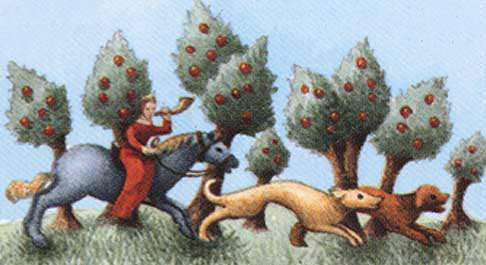
Bruane Says:
“The Four Hallowed nights are key to many of our practices. The calendar of the Ancients was kept by the moons and the tides of seasons. We of the Old Faith still try to mark the rising and falling tides of the year with reverence, for the great year-tides show the greatest image of the ever-moving serpent power. The Ancients saw the year in terms of a great cold-time and a great warm-time that battled a war of eternity; the life and death of the Sun itself being watched with awe.
We amongst the wise still track the sun through the sky, and wait for it to move into one of the great star-houses, and to open the gates of the Hallowed Nights, where we may slip through the “cracks of dawn and dusk” and enter into the Netherworld, there to join the others at the great Sabbatstead on the Meadow.
When the sun enters the House of the Scorpion, the great feast of Hallowmas is upon us. Then the great tide of darkness begins…and so begins the new year, for within darkness, all things begin. The red spirits of cold and misrule roam the land and bring with them a reign of fear, but those who know the old ways can still resist them and banish them. On the Hallowmas-tide, the spirits of the dead can return, and indeed, no night is better for contacting the Feeorin-dead and asking for their oracle than Hallowmas. The power that flows through creation, and sustains it, dissolves in this dark time, back into the primal chaos from whence it came. With its dissolution, the structure of reality is also weakened, allowing for the dead and the inhabitants of the worlds beyond to travel about, and for we here in middle-earth to do likewise. The fires lit in the Covensteads on this night are for the renewal and regeneration that we know must come after death…The Feeorin are said to track about on this night, and the Dark Rade can be a danger to those unprepared, or alone.
When the Sun enters into the House of the Water Bearer, then the Feast of Old Candlemas is upon us. This is the time which is in the very depth of winter’s darkness, and the time when the serpent beneath the mounds and fields emerges into renewal and new life. The power of the ground thus quickened, winter cannot last much longer. The Dark Rade is seen riding back down into the ground on these nights, not to emerge again until the darkness returns in the year to come. The Lady Renewed is invited to come into the homes and crofts and compasses of the people, to bring with her the blessings and promises of a summer to come, and of purification and growth.
When Sol enters the House of the Heavenly Bull, the great Feast of Old Belteine, or Roodmas is upon us. This is the feast which stands on the opposite end of the year-wheel from Hallowmas…This is the feast of the triumph of the light. The bright tide of summer starts here, and the marriage of Yarth, who is our Lady and the Great All-giver, and the Ellfed, who is the great Impregnator, is celebrated. The fertility of the Power of the Lady pulses forth and it fills all of her children.
She becomes pregnant and her fields give forth in abundance. The garlanded birch maypole and the may-eve fires are the objects of veneration for the People on this night, and love and the erotic mysteries preside over all. The predations and trickery of the Feeorin is ever a danger on Roodmas night, and the old people always left offerings out to stave off their dangers.
When the Sun enters the House of the Lion, the middle point of the Summer has been reached, and the decline of the light powers must begin. Such is the sacrificial theme of the Red Day, Lammas, Old Harvest Home. The full bounty of the Lady has been reaped, and what is given demands something in return. To ensure plenty will come again, the spirit of the Ellfed God, The Red King, is killed to feed the fields, and his life-giving spirit loses it’s power and descends into the world below, which is a return the Womb of the Lady which gave him birth in the first place. He will await renewal in the ground, as the seed awaits the breaking of winter to burst forth new in spring. For we believe that from every grave comes a new life. The flesh of the Lord of the Earth is threshed and ground, as the grain, and he is consumed in body and in blood as bread and barley-liquor, so that by his sacrifice we may live on. This is the truest meaning of “sacrifice”. To die so that others may live is not to die at all. His wake-fires burn high and long into the night and he is mourned by the People, though we know that he must return one day, as must we all, when the arms of death take us.”